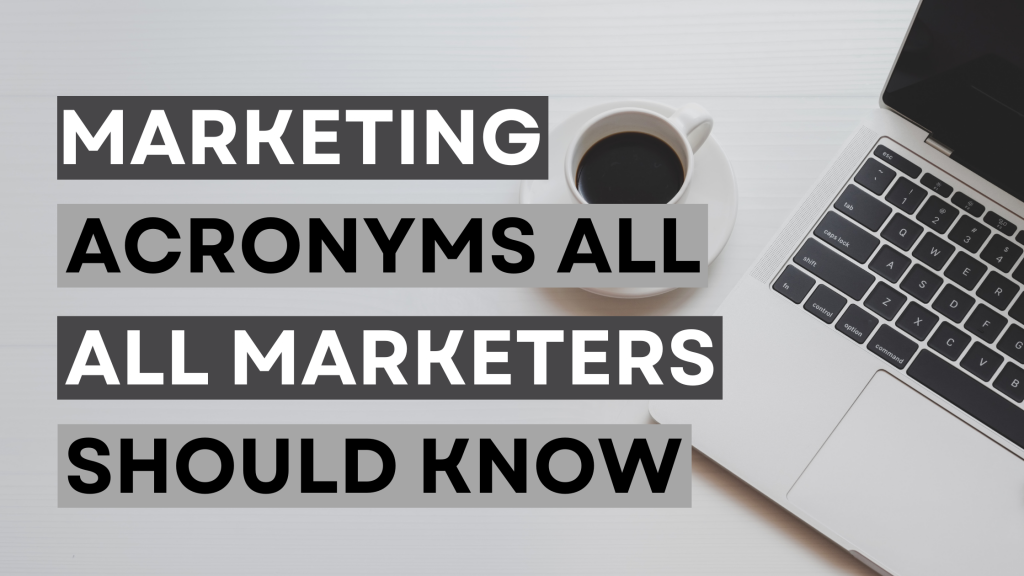Marketing is a dynamic and ever-evolving field, and with it comes a host of acronyms and jargon that can often leave newcomers feeling like they’re deciphering a secret code. In this blog post, we’ll unravel the mystery of common marketing acronyms, helping you navigate the marketing landscape with confidence. From SEO and CRM to KPIs and ROI, we’ll explore the essential acronyms that every marketer should know.
- ABM – Account-Based Marketing: Account-based marketing is a strategy where marketing efforts are concentrated on specific high-value target accounts. It involves personalized outreach and content tailored to individual accounts to increase the chances of conversion.
- AE – Account Executive: An Account Executive is a sales professional responsible for managing and nurturing relationships with specific clients or accounts. They play a crucial role in sales and business development.
- B2B – Business to Business: B2B companies sell products or services to other businesses.
- B2C – Business to Consumer: B2C companies sell directly to consumers.
- BDM – Business Development Manager: A business development manager is a professional responsible for identifying growth opportunities, building strategic relationships, and creating new business ventures for a company. They play a key role in expanding the organization’s reach and profitability.
- BR – Bounce Rate: Bounce Rate is a metric that measures the percentage of visitors who navigate away from a website after viewing only one page. A high bounce rate can indicate that visitors aren’t finding what they’re looking for or that the website’s content or design needs improvement.
- CMS – Content Management System: A CMS is a platform that enables easy creation and management of digital content. WordPress, Drupal, and Joomla are popular examples. Marketers use CMS to publish, edit, and organize content on websites without the need for coding skills.
- CPA – Cost Per Acquisition: CPA is the cost associated with acquiring a new customer through a marketing campaign. It’s calculated by dividing the total campaign cost by the number of new customers acquired.
- CPC – Cost Per Click: CPC is the price an advertiser pays each time a user clicks on their online ad. It’s a common pricing model for paid online advertising, such as Google AdWords.
- CPM – Cost Per 1000: CPM is a pricing model in online advertising where advertisers pay a set rate for every 1,000 ad impressions, regardless of whether users click on the ad or not.
- CR – Conversion Rate: The conversion rate is the percentage of website visitors who take a desired action, such as making a purchase, filling out a form, or signing up for a newsletter. A higher conversion rate indicates effective marketing.
- CRM – Customer Relationship Management: CRM software allows businesses to manage and analyze interactions with current and potential customers. It helps streamline sales and marketing processes, improve customer satisfaction, and build stronger, more profitable relationships with clients.
- CTA – Call to Action: A CTA is a prompt designed to elicit an immediate response from the audience. It can be in the form of a button, a link, or a statement like “Sign up now” or “Get started.” CTAs are critical for converting website visitors into leads or customers.
- CTR – Click-Through Rate: CTR is a metric used to assess the effectiveness of online advertising campaigns. It’s the ratio of clicks to impressions. A higher CTR indicates that more people are engaging with your content and ads.
- DSP – Demand Side Platform: A DSP is a technology platform used by advertisers and agencies to buy and manage digital advertising inventory. It helps marketers target their ads to specific audiences and optimize campaigns.
- GA – Google Analytics: Google Analytics is a web analytics service provided by Google that tracks and reports website traffic. It offers valuable insights into user behavior, helping marketers make data-driven decisions.
- KPI – Key Performance Indicator: KPIs are metrics that businesses use to evaluate the success of marketing strategies. Common KPIs include website traffic, conversion rates, customer acquisition cost, and customer lifetime value. They guide decision-making and indicate areas that require attention.
- LPV – Landing Page Views: LPV is a metric that tracks the number of times a landing page has been viewed. Landing pages are often used to capture leads or encourage specific actions from visitors.
- PPC – Pay-Per-Click: PPC advertising is a model in which advertisers pay a fee each time their ad is clicked. Google AdWords and social media advertising platforms like Facebook Ads use PPC. It’s a way to buy visits to your website rather than earning them organically.
- PPV – Pay-Per-View: PPV is a pricing model in the world of television and online video, where viewers pay to watch a specific program or event. In online marketing, it’s sometimes used to refer to the number of views or impressions of a video advertisement.
- PR – Public Relations: Public Relations involves managing the image and reputation of a company or brand through media coverage, communication, and relationship-building. It’s an essential part of marketing and brand management.
- ROI – Return on Investment: ROI measures the profitability of a marketing campaign or strategy. It’s the ratio of the net gain or loss from an investment to the initial cost of the investment. Calculating ROI helps businesses determine the effectiveness of their marketing efforts.
- RTB – Real-Time Bidding: RTB is a method of buying and selling online advertising in real-time auctions. It allows advertisers to bid on ad space to display their ads to specific audiences as web pages load.
- SEM – Search Engine Marketing: SEM encompasses the use of paid advertising to gain visibility on search engines like Google. It includes both PPC (pay-per-click) and SEO (search engine optimization) efforts to improve a website’s ranking.
- SEO – Search Engine Optimization: SEO is the art and science of improving a website’s visibility on search engines like Google. By optimizing content, meta tags, and other elements, marketers aim to rank higher in search engine results, driving more organic (unpaid) traffic to their websites.
- SLA – Service Level Agreement: An SLA is a contract that outlines the level of service a customer can expect from a business. In marketing, SLAs often define expectations between marketing and sales teams to ensure smooth lead generation and conversion processes.
- SMM – Social Media Marketing: SMM involves using social media platforms like Facebook, Twitter, and Instagram to promote products or services. It’s an effective way to engage with an audience, build brand awareness, and drive website traffic.
- SOV – Share of Voice: Share of Voice is a metric that measures a brand’s presence in a specific market or industry compared to competitors. It indicates the portion of advertising within a given space or time period.
- UGC – User-Generated Content: UGC is content created by customers, users, or fans of a brand. It includes reviews, social media posts, photos, and videos. UGC can be a powerful marketing tool as it showcases authentic, positive experiences with a product or service.
- USP – Unique Selling Point: A USP is what sets a product or service apart from the competition. It’s a unique feature or benefit that makes a brand or offering more attractive to customers.
- UX – User Experience: User Experience focuses on the overall experience users have when interacting with a product, website, or service. A positive UX is essential for keeping visitors engaged and converting
- WOM – Word of Mouth: Word of Mouth refers to the spread of information, recommendations, or opinions about a product, service, or business through informal conversations and discussions among people. It is often considered one of the most powerful forms of marketing, as it relies on personal experiences and trusted networks.
Mastering marketing acronyms is an essential step in becoming a successful marketer. These abbreviations are the language of the industry, enabling professionals to communicate, analyze, and optimize their strategies effectively. Whether you’re focusing on SEO, measuring ROI, or crafting compelling CTAs, understanding these acronyms will empower you to navigate the complex world of marketing with confidence. Are there any acronyms that you use often that I missed? I’d love to hear in the comments!


